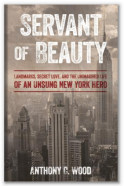
An Oral History with Frank Gilbert
October 14, 2011 | by Ben Baccash
Article from the Fall 2011 Newsletter
Preservation is personal. It’s personal for the dedicated professionals who work in the field and for the volunteers who fight the neighborhood battles to protect their own quality of life. However, in both cases, the personal experiences are too often undocumented. Surely the situational facts of the individual fights are recorded in a few books, sometimes in a periodical or, more recently, on blogs. But the personal details – those which bring the conflicts and resolutions to life – are neglected. This may be a service to the wider, non-preservationist audience, or simply a function of a limited word count, but it’s important to remember that these details – the emotions, the quips, the forgotten names of second tier players, or an explanation of a seemingly minor event at the time – often shed light on broader historical circumstances. This is why oral histories are so important.
Working in association with the Archive Project, I sat down this past March with Frank Gilbert, the Landmarks Preservation Commission’s first staff lawyer who held the positions of secretary and executive director during his tenure. Recently retired from the National Trust for Historic Preservation, Mr. Gilbert discussed with me his experiences at the then-nascent LPC for approximately seven hours over two days. The result is a transcript of over fifty pages rife with details that, had the oral history not been conducted, would have been lost. Mr. Gilbert remembers being served with the papers that spurred the Penn Central case, which established the constitutionality of the Landmarks Law, and he recalls a conversation with representatives of The Plaza Hotel, before its designation, who asked why he believed their building was a landmark, to which Gilbert replied “I’ve read your advertising.” Mr. Gilbert even remembers attending a hearing at the Appellate Division of the New York State Supreme Court with Geoffrey Platt, the LPC’s first chair, who realized the mural behind the presiding judge depicted Platt’s mother, a society figure. My personal favorite: Mr. Gilbert describes a sign that he kept on his desk at the LPC, before the Penn Central case was finally decided, that read, “This Law Raises Grave Constitutional Questions.” He would point to this sign whenever a lawyer entered his office insisting on the Landmarks Law’s illegality.
These seemingly random recollections are but a few in the context of a larger, historical timeline which Mr. Gilbert sharply narrated and that, thanks to the New York Preservation Archive Project and its supporters, is now recorded in a transcript that will soon be publicly available. NYPAP’s Oral History Program is an ongoing effort, and its benefits may not be fully realized. Oral histories need to be unpacked from a distance that allows critical analysis of the facts and musings therein, as these at-length interviews are as much about the subjects and their personalities as they are about preservation and its state at the time of the discussed experiences. It is imperative that oral histories such as the one I conducted with Frank Gilbert continue to be carried out while the players are still available. While oral histories are conversations between an interviewer and an interviewee, when considered at a later date, oral histories allow for an inter-generational dialogue that is invaluable to the current assessment and future improvement of historic preservation.




